Soft and tender rice noodle sheets filled with firm and tasty shrimp.
Drizzled with a seasoning sauce for a light, delicious, and easy to make dish.
These steamed rice rolls are the perfect meal to make for lunch or even dinner.
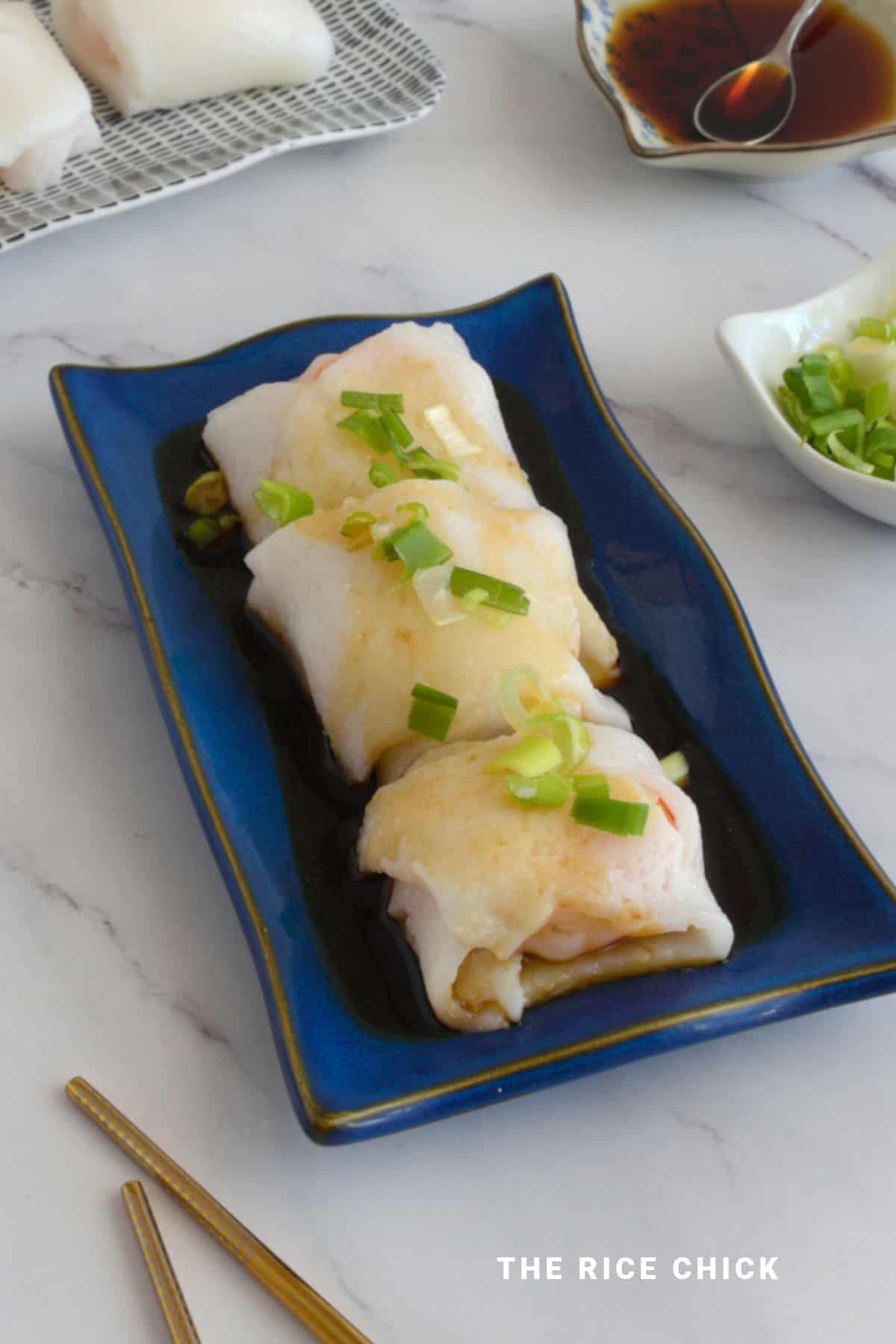
Jump to:
- What is cheung fun?
- What is the difference between Banh Cuon and cheung fun?
- Why You'll Love This Recipe
- Cost To Make
- Ingredients
- Equipment
- Instructions
- Tips for Success
- Substitutions / Variations
- Serving Suggestions
- Storage
- FAQ
- What rice is used for what?
- Helpful Rice Cooking Tips
- More Mains Recipes
- Recipe
- Comments
Steamed rice rolls, also known as cheung fun, are an easy to make dish perfect any time of year.
You can make this popular dim sum classic in the comfort of your own home.
With just a few simple ingredients, these rice rolls can be made for any occasion. Enjoy them plain, garnished with chopped green onions, or fill them with shrimp.
What is cheung fun?
Cheung fun, also known as steamed rice rolls, is a popular Chinese dish made from wide, flat rice noodle sheets.
These sheets are steamed and then often filled or served with various ingredients like shrimp, beef, or vegetables.
The dish is known for its smooth and slightly chewy texture and is commonly enjoyed with a flavorful sauce, such as soy sauce or hoisin sauce.
Cheung fun is a popular dim sum item and can be found in many Chinese restaurants worldwide.

What is the difference between Banh Cuon and cheung fun?
Banh cuon and cheung fun are both rice noodle dishes, but they differ in origin, flavor, and presentation.
Banh cuon is Vietnamese, featuring translucent rice sheets filled with a mixture of ground pork and mushrooms, offering a lighter and fresher taste with herb-infused dipping sauce.
Cheung fun, a Chinese dish, uses wide rice sheets that can be filled with various ingredients, providing a range of flavors, and is often served rolled or flat.
Why You'll Love This Recipe
- These steamed rice rolls are gluten free.
- Fill these rice rolls with a filling of your choice. Instead of shrimp, you could use chopped cooked meats like char siu pork.
- Perfect to enjoy all year round, for weeknight dinners, lazy weekends, dinner parties, or even special occasions like Christmas.
Cost To Make
Estimated cost = $8.65, or $0.72 a roll
Ingredients
Please note that below is a guide for some of the ingredients we used in the recipe. The printable recipe further down the page has the complete list of ingredients, including quantities and step-by-step instructions.

For the Rolls
- Rice Flour
- Tapioca starch or wheat starch
- Water: Room temperature, plus extra to fill your steamer.
- Salt: Salt will be used to season the rolls as well as lightly salt the shrimp.
- Neutral flavored oil, such as vegetable oil
- Shrimp (prawns): Peeled and devained
- Green Onion (Spring Onion): Finely chopped, to garnish
For the Sauce
- Water
- Light Soy Sauce: You can use gluten free soy sauce.
- Dark Soy Sauce: You can use gluten free soy sauce.
- White sugar
Equipment
Ideally, you will need a large steamer and a sheet pan (baking tray) at least 18 cm x 18cm (7 inch x 7 inch)and at least 1 to 2 cm (0.40 inches to 0.80 inches) deep.
Or a tray small enough to fit into your steamer.
Instructions
This recipe for steamed rice rolls makes about 10 to 12 rice rolls. The ingredient quantities can easily be adjusted to suit how many serves you need to make.
For the Sauce
Step One: Place all sauce ingredients in a small saucepan over medium heat. Cook until the sugar is dissolved and then turn off the heat. Set aside and allow to cool.
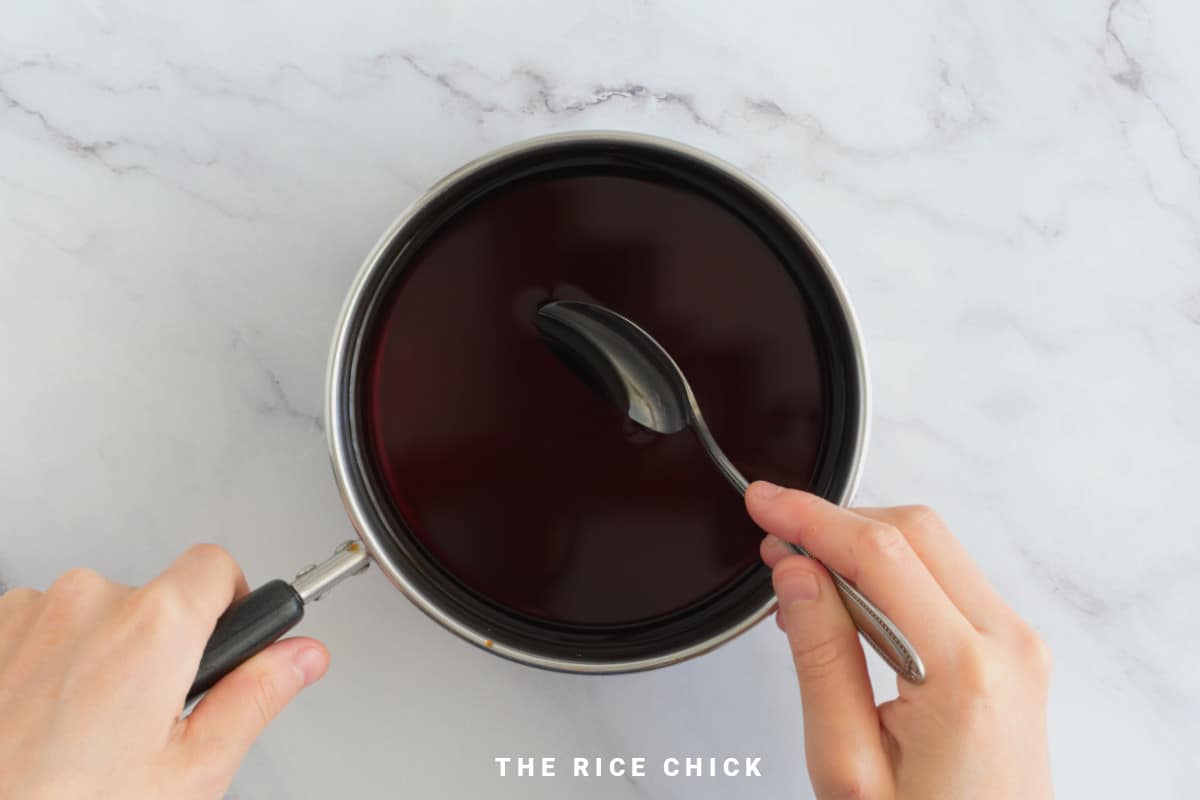
For the Rolls
Step One: Heat water in a steamer and bring the water to a rolling boil. You do not want the water of your steamer to touch the bottom tray. Do not overfill your steamer with water.
Step Two: While the water is heating, mix the rice flour, tapioca starch, half of the room temperature water, and salt in a medium to large sized bowl or jug.
Make sure there are no lumps and the ingredients are mixed well.
Then mix through the remaining water. Set aside.
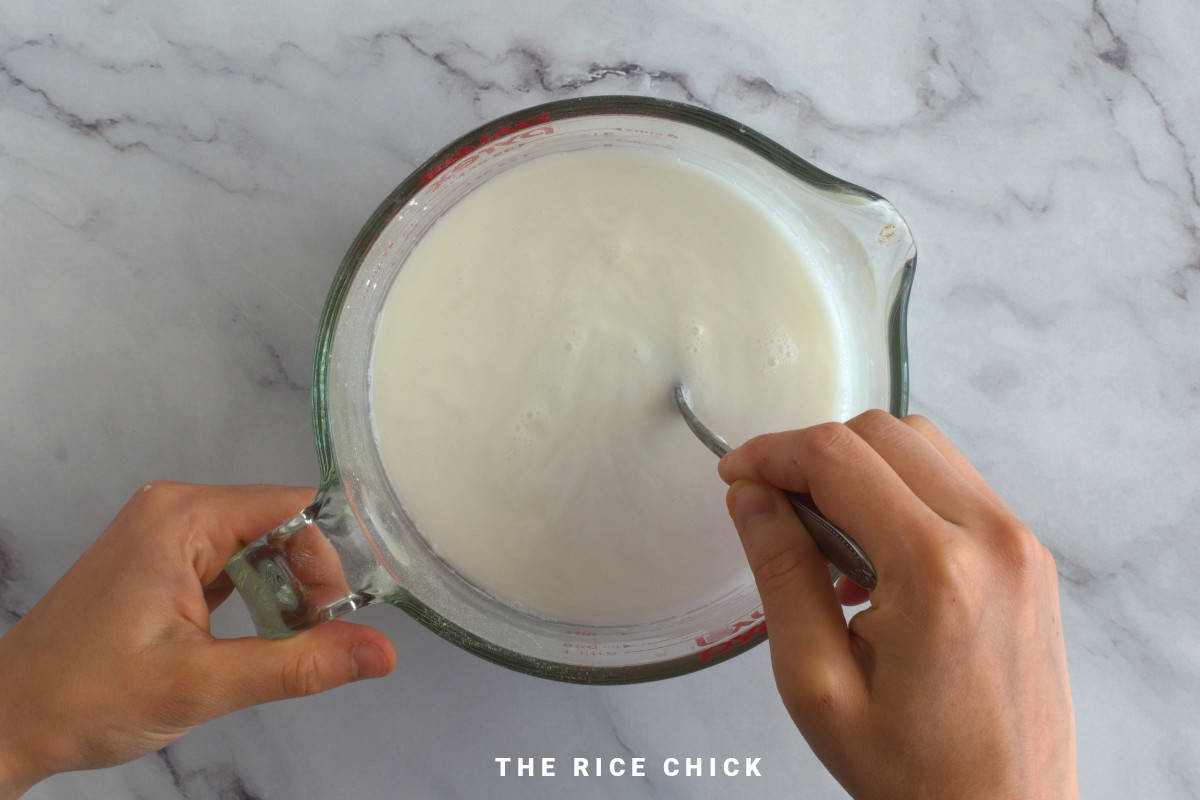
Step Three: Lightly salt the prawns. Set aside.
Step Four: Once the steamer is hot, brush a thin layer of oil over a small baking tray (sheet pan) that fits into your steamer.
Place the tray into the steamer. Pour a small amount of batter into the baking tray, enough to thinly cover the surface of the tray.
We used about ¼ cup (60ml/grams, 2.13 ounces) of batter for an 18cm x 18cm (7 inch x 7 inch) tray.
Cover the steamer with a lid and allow the batter to cook for about 1 minute, or until the batter is starting to thicken.

Step Five: Remove lid and place some shrimp in the middle of the batter in a line.
Cover steamer again and cook for a further 2 to 3 minutes, or until the shrimp are cooked and the batter is cooked.
To tell if the batter is cooked, it should be firm to the touch and slightly sticky. It should no longer be translucent, and should be a solid white color.
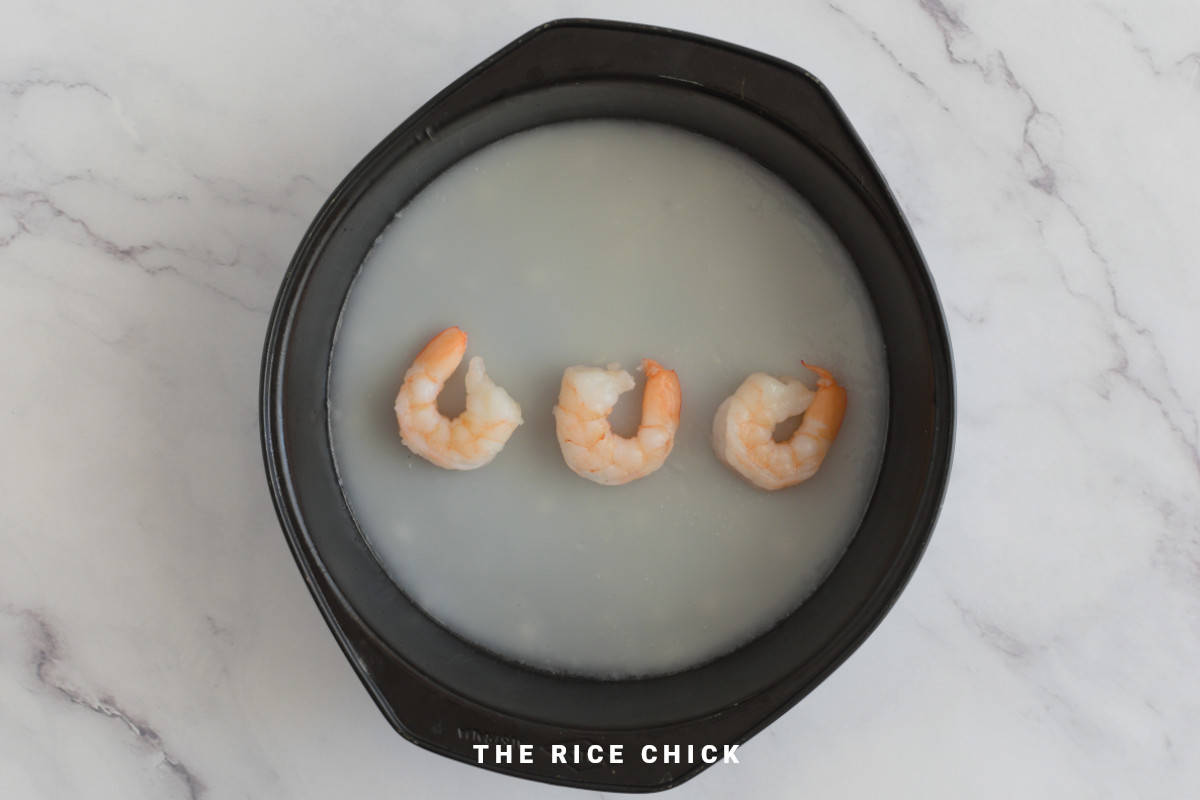
Step Six: Turn the heat to low, remove lid from the steamer and carefully remove the tray.
Allow the tray to cool slightly before using a spatula (or scraper) to gently lift the sheet from one end and roll it towards the other end, covering the shrimp.
It can help to gently run a spoon around the edge of the tray to loosen the rice sheet before you roll it up.
Remove from tray.
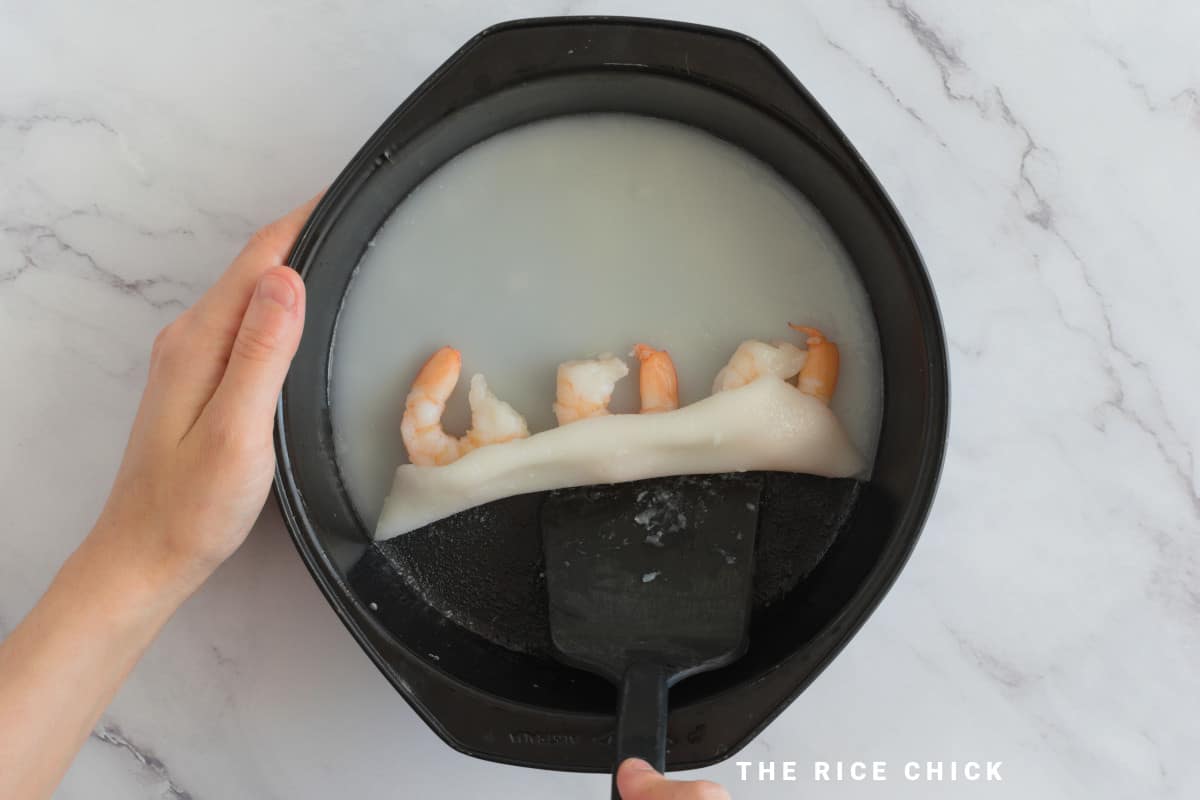
Step Seven: Turn heat to high once more, and repeat steps 2 and 3 for remaining ingredients.
Before pouring the batter into the tray again, stir the mixture.
If you want to speed up the cooking process, you could use two baking trays (sheet pans).
Have one prepared with some raw batter while one is cooking in the steamer. When the one in the steamer is cooked and removed, place the other tray in the steamer.
Step Eight: Transfer steamed rolls to a serving plate. If desired, cut into bite-sized pieces. Then pour cooled sauce over rolls and garnish with chopped spring onions.
Tips for Success
- Ensure there are no lumps in your batter.
- Lightly oil the steaming tray or surface to prevent sticking when you are cooking your rice rolls.
- Spread the batter thinly and evenly. You don't want to overcrowd the steamer.
- Don't be discouraged by your initial attempts at making these rice rolls if it doesn't work out. It can take some practice to achieve the desired appearance and texture.
- A note about shrimp (prawns): For this recipe, we use medium sized shrimp. If you use extra large shrimp or thick shrimp, you may need to cut them in half horizontally (lengthwise). Likewise, if you use small shrimp, you may need to use more to fill your rolls.
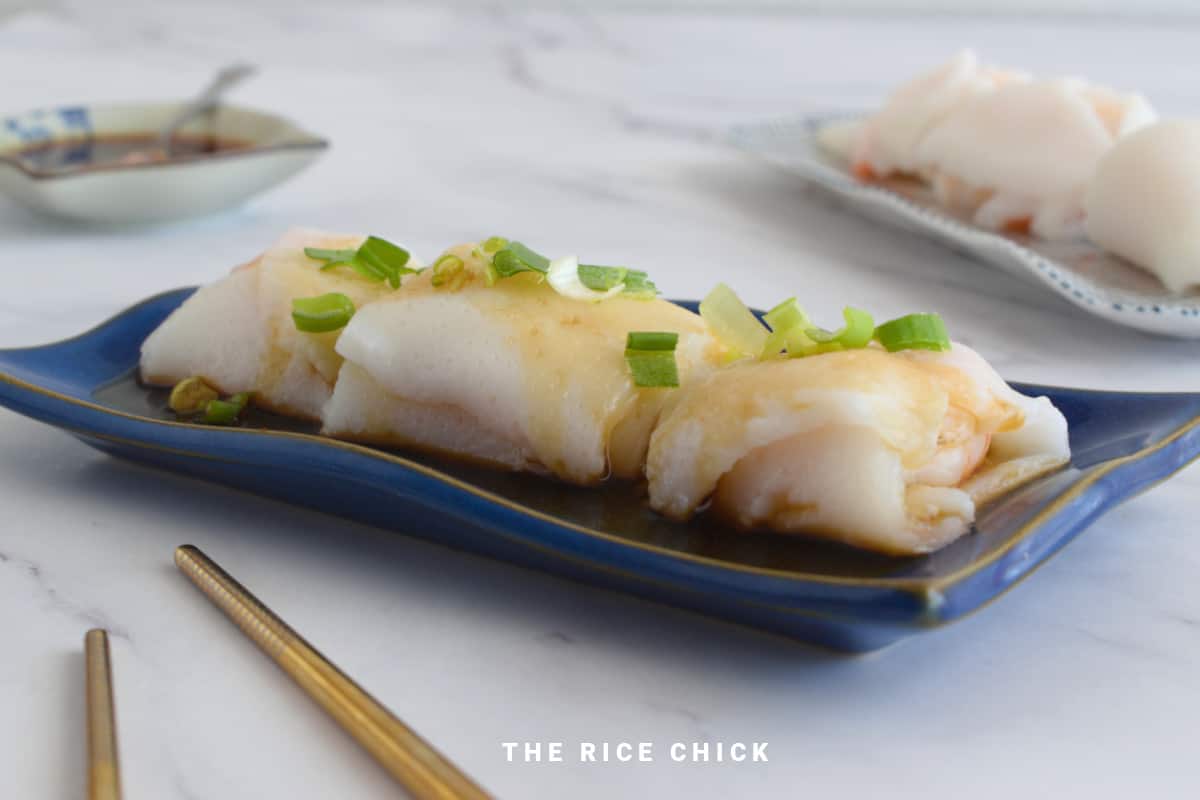
Substitutions / Variations
Instead of shrimp, you might like to fill these rice rolls with:
- Char siu meat, such as pork, chopped into small pieces
- Chinese fried doughnut sticks (you tiao)
- Eggs
- Dried shrimp
- Enjoy them plain with dipping sauce
Serving Suggestions
- Chopped green (spring) onions
- Dried onions
Storage
These steamed rice rolls are best eaten on the day they are made.
However, you can store them in an air tight container in the fridge for up to 1 to 2 days.
Try not to have the rolls touching when storing as they can stick together.
FAQ
A steamed rice roll is commonly referred to as "cheung fun" in Cantonese cuisine.
Steamed rice rolls are typically made from a batter of rice flour, water, and sometimes a small amount of starch.
If you find your steamed rice rolls are cracking, it could be due to the rice rolls cooling down too quickly or you did not use enough batter when steaming.
What rice is used for what?
Ever wondered which might be the best rice to use for a dish you're about to make.
Or maybe you're just curious and want to know more about rice in general.
Why not check out our pages on what is basmati rice and what is jasmine rice.
Helpful Rice Cooking Tips
Want to know how to cook rice or just need a little refresher?
Check out how to easily cook basmati rice, sushi rice, and jasmine rice on the stovetop.
Or, why not check out our recipes on how to make basmati rice, jasmine rice, and sushi rice in the Instant Pot.

Made this recipe? Let us know how it went in the comments below! We'd love to hear how it turned out.
Recipe

Steamed Rice Rolls
Equipment
- Ideally, you will need a large steamer and a sheet pan (baking tray) at least 18 cm x 18cm (7 inch x 7 inch) and at least 1 to 2 cm (0.40 inches to 0.80 inches) deep. Or a tray small enough to fit into your steamer.
Ingredients
For the Sauce
- ½ cup (125 ml/grams, 4.40 ounces) water
- 2 teaspoons light soy sauce you can use gluten free soy sauce.
- ½ teaspoon dark soy sauce you can use gluten free soy sauce.
- ½ teaspoon white sugar
For the Rolls
- 200 grams (7.05 ounces) rice flour
- 50 grams (1.76 ounces) tapioca starch or wheat starch
- 4 ½ cups (1125 grams, 39.70 ounces) water room temperature, plus extra to fill your steamer
- ¼ teaspoon salt plus extra to salt the shrimp
- 2 teaspoon neutral flavored oil such as vegetable oil
- 350 grams (12.40 ounces) shrimp (prawns), peeled and devained
- ¼ cup (20 grams, 0.71 ounces) green onion (spring onion) finely chopped, to garnish
Instructions
For the Sauce
- Place all sauce ingredients in a small saucepan over medium heat. Cook until the sugar is dissolved and then turn off the heat. Set aside and allow to cool.
For the Rolls
- Heat water in a steamer and bring the water to a rolling boil. (see note 1).
- While the water is heating, mix the rice flour, tapioca starch, half of the room temperature water, and salt in a medium to large sized bowl or jug. Make sure there are no lumps and the ingredients are mixed well. Then mix through the remaining water. Set aside.
- Lightly salt the prawns. Set aside.
- Once the steamer is hot, brush a thin layer of oil over a small baking tray (sheet pan) that fits into your steamer. Place the tray into the steamer. Pour a small amount of batter into the baking tray, enough to thinly cover the surface of the tray. (see note 2). Cover the steamer with a lid and allow the batter to cook for about 1 minute, or until the batter is starting to thicken.
- Remove lid and place some shrimp in the middle of the batter in a line. Cover steamer again and cook for a further 2 to 3 minutes, or until the shrimp are cooked and the batter is cooked. (see note 3).
- Turn the heat to low, remove lid from the steamer and carefully remove the tray. Allow the tray to cool slightly before using a spatula (or scraper) to gently lift the sheet from one end and roll it towards the other end, covering the shrimp. It can help to gently run a spoon around the edge of the tray to loosen the rice sheet before you roll it up. Remove from tray.
- Turn heat to high once more, and repeat steps 2 and 3 for remaining ingredients. Before pouring the batter into the tray again, stir the mixture. (see note 4).
- Transfer steamed rolls to a serving plate. If desired, cut into bite-sized pieces. Then pour cooled sauce over rolls and garnish with chopped spring onions.
Notes
- You do not want the water of your steamer to touch the bottom tray. Do not overfill your steamer with water.
- We used about ¼ cup (60ml/grams, 2.13 ounces) of batter for an 18cm x 18cm (7 inch x 7 inch) tray.
- To tell if the batter is cooked, it should be firm to the touch and slightly sticky. It should no longer be translucent, and should be a solid white color.
- If you want to speed up the cooking process, you could use two baking trays (sheet pans). Have one prepared with some raw batter while one is cooking in the steamer. When the one in the steamer is cooked and removed, place the other tray in the steamer.
- A note about shrimp (prawns). For this recipe, we use medium sized shrimp. If you use extra large shrimp or thick shrimp, you may need to cut them in half horizontally (lengthwise). Likewise, if you use small shrimp, you may need to use more to fill your rolls.
- Don't be discouraged by your initial attempts at making these rice rolls if it doesn't work out. It can take some practice to achieve the desired appearance and texture.
- Char siu meat, such as pork, chopped into small pieces
- Chinese fried doughnut sticks (you tiao)
- Eggs
- Dried shrimp
- Enjoy them plain with dipping sauce





Comments
No Comments